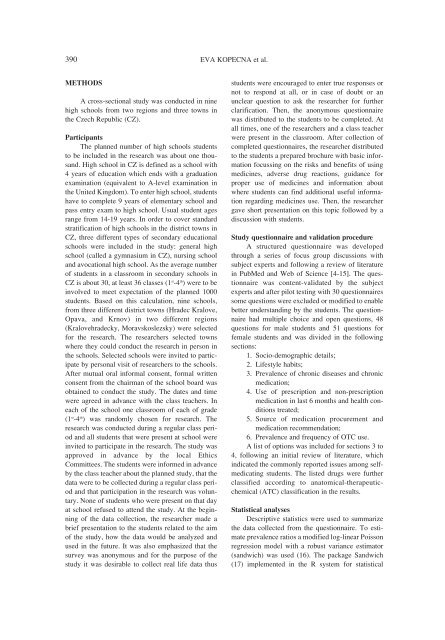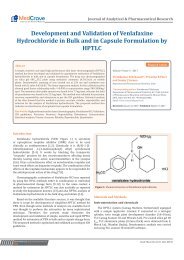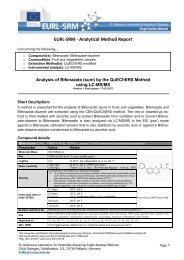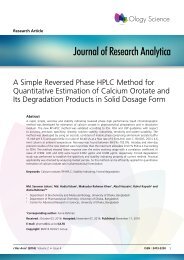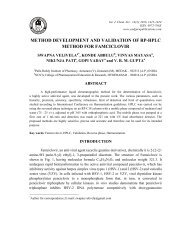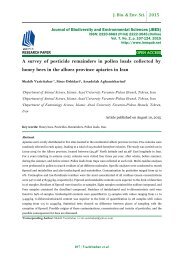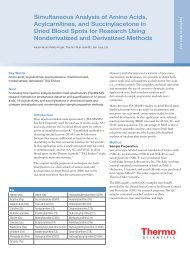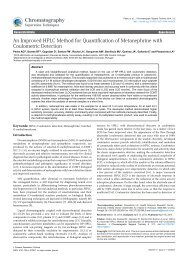acta 2_2015
acta 2_2015
acta 2_2015
- No tags were found...
You also want an ePaper? Increase the reach of your titles
YUMPU automatically turns print PDFs into web optimized ePapers that Google loves.
390 EVA KOPECNA et al.METHODSA cross-sectional study was conducted in ninehigh schools from two regions and three towns inthe Czech Republic (CZ).ParticipantsThe planned number of high schools studentsto be included in the research was about one thousand.High school in CZ is defined as a school with4 years of education which ends with a graduationexamination (equivalent to A-level examination inthe United Kingdom). To enter high school, studentshave to complete 9 years of elementary school andpass entry exam to high school. Usual student agesrange from 14-19 years. In order to cover standardstratification of high schools in the district towns inCZ, three different types of secondary educationalschools were included in the study: general highschool (called a gymnasium in CZ), nursing schooland avocational high school. As the average numberof students in a classroom in secondary schools inCZ is about 30, at least 36 classes (1 st -4 th ) were to beinvolved to meet expectation of the planned 1000students. Based on this calculation, nine schools,from three different district towns (Hradec Kralove,Opava, and Krnov) in two different regions(Kralovehradecky, Moravskoslezsky) were selectedfor the research. The researchers selected townswhere they could conduct the research in person inthe schools. Selected schools were invited to participateby personal visit of researchers to the schools.After mutual oral informal consent, formal writtenconsent from the chairman of the school board wasobtained to conduct the study. The dates and timewere agreed in advance with the class teachers. Ineach of the school one classroom of each of grade(1 st -4 th ) was randomly chosen for research. Theresearch was conducted during a regular class periodand all students that were present at school wereinvited to participate in the research. The study wasapproved in advance by the local EthicsCommittees. The students were informed in advanceby the class teacher about the planned study, that thedata were to be collected during a regular class periodand that participation in the research was voluntary.None of students who were present on that dayat school refused to attend the study. At the beginningof the data collection, the researcher made abrief presentation to the students related to the aimof the study, how the data would be analyzed andused in the future. It was also emphasized that thesurvey was anonymous and for the purpose of thestudy it was desirable to collect real life data thusstudents were encouraged to enter true responses ornot to respond at all, or in case of doubt or anunclear question to ask the researcher for furtherclarification. Then, the anonymous questionnairewas distributed to the students to be completed. Atall times, one of the researchers and a class teacherwere present in the classroom. After collection ofcompleted questionnaires, the researcher distributedto the students a prepared brochure with basic informationfocussing on the risks and benefits of usingmedicines, adverse drug reactions, guidance forproper use of medicines and information aboutwhere students can find additional useful informationregarding medicines use. Then, the researchergave short presentation on this topic followed by adiscussion with students.Study questionnaire and validation procedureA structured questionnaire was developedthrough a series of focus group discussions withsubject experts and following a review of literaturein PubMed and Web of Science [4-15]. The questionnairewas content-validated by the subjectexperts and after pilot testing with 30 questionnairessome questions were excluded or modified to enablebetter understanding by the students. The questionnairehad multiple choice and open questions, 48questions for male students and 51 questions forfemale students and was divided in the followingsections:1. Socio-demographic details;2. Lifestyle habits;3. Prevalence of chronic diseases and chronicmedication;4. Use of prescription and non-prescriptionmedication in last 6 months and health conditionstreated;5. Source of medication procurement andmedication recommendation;6. Prevalence and frequency of OTC use.A list of options was included for sections 3 to4, following an initial review of literature, whichindicated the commonly reported issues among selfmedicatingstudents. The listed drugs were furtherclassified according to anatomical-therapeuticchemical(ATC) classification in the results.Statistical analysesDescriptive statistics were used to summarizethe data collected from the questionnaire. To estimateprevalence ratios a modified log-linear Poissonregression model with a robust variance estimator(sandwich) was used (16). The package Sandwich(17) implemented in the R system for statistical


